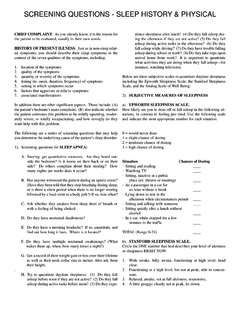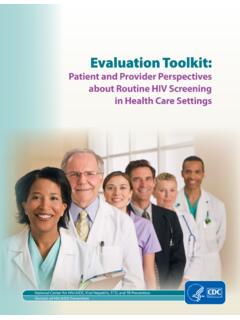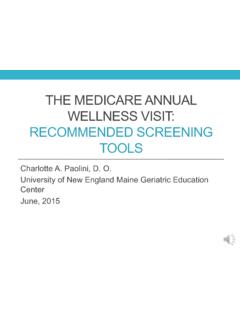Transcription of Audiometry Screening and Interpretation
1 January 1, 2013 Volume 87, Number 1 American Family Physician 41 Audiometry Screening and InterpretationJENNIFER JUNNILA WALKER, MD, MPH, Army Health Clinic, Schofield Barracks, HawaiiLEANNE M. CLEVELAND, AuD, Fort Richardson Troop Health Clinic, Joint Base Elmendorf-Richardson, AlaskaJENNY L. DAVIS, AuD, Landstuhl Regional Medical Center, Landstuhl, GermanyJENNIFER S. SEALES, AuD, General Leonard Wood Army Community Hospital, Fort Leonard Wood, Missouri Nearly 30 million American adults have some degree of hearing The prevalence of hearing loss varies with age; at least 25 percent of patients between 51 and 65 years of age, and more than 50 percent of patients older than 80 years, have objective evidence of hearing ,3 Particularly con-cerning is the increasing prevalence of hear-ing loss in adolescents and young adults, which affects between 8 and 19 percent of this ,4 The Preventive Ser-vices Task Force (USPSTF)
2 Finds insufficient evidence for or against Screening for hear-ing loss in asymptomatic adults 50 years or However, the USPSTF does affirm the effectiveness of Screening question-naires and clinical techniques such as the whispered voice, finger rub, and watch tick tests, all of which can be performed in the primary care ,5,6 Other guidelines list subjective hearing Screening as a preven-tive service that should be offered to adults starting at 40 years of is a relatively simple procedure that can be performed and interpreted by a trained health care professional. Family phy-sicians should feel comfortable performing this testing on adults and cooperative chil-dren. Physicians may consider performing Audiometry when a patient reports a subjec-tive sense of diminished hearing, or when a family member reports a patient s decreased conversational the USPSTF also found insuffi-cient evidence to recommend for or against routinely Screening asymptomatic working-age adolescents and adults younger than 50 years for hearing impairment,3 other organizations have recommended regu-lar periodic objective testing throughout childhood and ,10 One sur-vey of adolescents and young adults (mean age years)
3 Revealed that 43 percent of respondents experienced hearing loss associ-ated with exposure to loud music within the past six Adolescents often listen to music through headphones at maximum vol-ume, and underestimate their vulnerability to music-induced hearing Therefore, patients reporting exposure to loud music or occupational noise are good candidates for aud iomet r may be expanded to include patients who are exposed to excessive noise while at work or at play who have not used adequate hearing protection. Unilateral or asymmetri-cal hearing loss is common in hunters and military veterans exposed to acoustic trauma from prolonged use of prevalence of hearing loss varies with age, affecting at least 25 percent of patients older than 50 years and more than 50 percent of those older than 80 years. Adolescents and young adults represent groups in which the prevalence of hearing loss is increasing and may therefore benefit from Screening .
4 If offered, Screening can be performed peri-odically by asking the patient or family if there are perceived hearing problems, or by using clinical office tests such as whispered voice, finger rub, or Audiometry . Audiometry in the family medicine clinic setting is a relatively simple procedure that can be interpreted by a trained health care professional. Pure-tone testing presents tones across the speech spectrum (500 to 4,000 Hz) to determine if the patient s hearing levels fall within normal limits. A quiet test-ing environment, calibrated audiometric equipment, and appropriately trained personnel are required for in-office testing. Pure-tone Audiometry may help physicians appropriately refer patients to an audiologist or otolaryngologist. Unilateral or asymmetrical hearing loss can be symptomatic of a central nervous system lesion and requires addi-tional evaluation. (Am Fam Physician. 2013;87(1):41-47. Copyright 2013 American Academy of Family Physicians.)
5 More online at from the American Family Physician Web site at Copyright 2013 American Academy of Family Physicians. For the private, noncommercial use of one individual user of the Web site. All other rights reserved. Contact for copyright questions and/or permission American Family Physician Volume 87, Number 1 January 1, 2013 Pure-Tone AudiometryWhen hearing loss is suspected, pure-tone Audiometry may be used to evaluate hearing deficits by spot-checking certain frequen-cies, or to evaluate deficits more Pure-tone Audiometry is performed with the use of an audiometer. Handheld audi-ometers have a sensitivity of 92 percent and a specificity of 94 percent in detecting sen-sorineural hearing There are several types of audiometers available, but all function similarly by allowing the tester to increase and decrease the intensity (loud-ness, in decibels [dB]) and frequency (pitch, in cycles per second or Hz) of the signal as Audiometry is broadly defined as either Screening or threshold search.
6 Screening Audiometry presents tones across the speech spectrum (500 to 4,000 Hz) at the upper lim-its of normal hearing (25 to 30 dB for adults, and 15 to 20 dB for children).17 Results are recorded as pass, indi-cating that the patient s hearing levels are within normal limits, or refer, indicating that hearing loss is possible and a repeat Screening test or a threshold search test is search Audiometry determines the softest sound a patient can hear at each frequency 50 percent of the time. This testing requires more time and exper-tise than Screening Audiometry . The American Speech- Language-Hearing Association has a recommended procedure for pure-tone threshold search tests known as the modified Hughson-Westlake Te s t i n g begins with the ear in which the patient perceives to have better hearing. The tester presents a pure tone at a clearly audible level.
7 After the patient responds to the pure-tone signal, the tester decreases intensity by 10 dB and pres-ents the tone again. If the patient responds to this tone, a down 10 pattern is employed, with the tester decreas-ing the intensity of the tone by 10 dB and presenting a tone until the patient no longer The tester then increases tone intensity by 5 dB until the patient responds. This is the patient s initial ascending response. To check for accuracy, the tester should decrease the intensity of the tone by 10 dB one more time to check for no response, then increase the intensity of the signal in 5 dB increments until the patient responds again to the signal. If the patient responds consistently (minimum two out of three responses in ascending order), the tes-ter records the dB level at which the patient responds as the air conduction threshold. After testing the ear that is perceived to have better hearing, the tester then per-forms the same tests on the patient s other ear.
8 Testing should begin at 1,000 Hz, because this fre-quency is easily heard by most patients and has the greatest test-retest A common frequency sequence for pure-tone threshold search testing is to test at 1,000, 2,000, 3,000, 4,000, 8,000, 1,000 (repeat), 500, and 250 frequency (ranging from low to high pitch) is recorded on the audiogram s horizontal axis. Sound intensity is recorded on the vertical axis. Right ear thresholds are manually recorded as a red circle on the audiogram. Left ear thresholds are manually recorded as a blue X (Figures 1 to 4B). Conventional pure-tone testing is used for adults and older children. Audiometry is more challenging in patients younger than five years, and these patients should be referred to an audiologist with experience treat-ing In many cases, the accuracy of pure-tone testing during well-child visits is overwhelmingly Considerations Affecting Audiometry InterpretationENVIRONMENTPure-tone Audiometry requires a quiet testing environ-ment with low levels of background noise.
9 Background noise can cause elevated thresholds, especially in low fre-quencies (eFigures 1A and 1B). To minimize the number of false-positive results, sound levels in the test environ-ment should not exceed American National Standards Institute (ANSI) A quiet booth that features sound-absorptive materials such as carpeting, SORT: KEY RECOMMENDATIONS FOR PRACTICEC linical recommendationEvidence ratingReferencesThe Preventive Services Task Force concludes that the current evidence is insufficient to assess the balance of benefits and harms of Screening for hearing loss in asymptomatic adults 50 years and reporting regular exposure to loud music or occupational noise are good candidates for Screening Audiometry . C11-13 Patients should avoid loud noise for at least 14 hours before pure-tone testing to minimize temporary threshold shift confounding of test with persistent unilateral or asymmetrical hearing loss should be offered additional evaluation and , 34A = consistent, good-quality patient-oriented evidence; B = inconsistent or limited-quality patient-oriented evidence; C = consensus, disease-oriented evidence, usual practice, expert opinion, or case series.
10 For information about the SORT evidence rating system, go to 1, 2013 Volume 87, Number 1 American Family Physician 43acoustic foam, or tiles is considered standard practice. Industrial hygienists, biomedical maintenance techni-cians, and audiologists can evaluate environmental noise levels in the test area using a sound level meter to ensure that ANSI specifications are types of audiometers are available for purchase, ranging from handheld Screening audiometers to those with full diagnostic capabilities extending to higher fre-quencies. Screening audiometers for office use, for exam-ple, generally test at frequencies in the speech range of 500 to 4,000 are many purchase options to consider for ear-phones and transducers. Circumaural headphones have a cushion covering the entire external ear. These help reduce background noise when the testing environ-ment is not ideal. Supra-aural headphones sit directly on the pinna, and are the least effec-tive headphone at attenuating background noise.
















